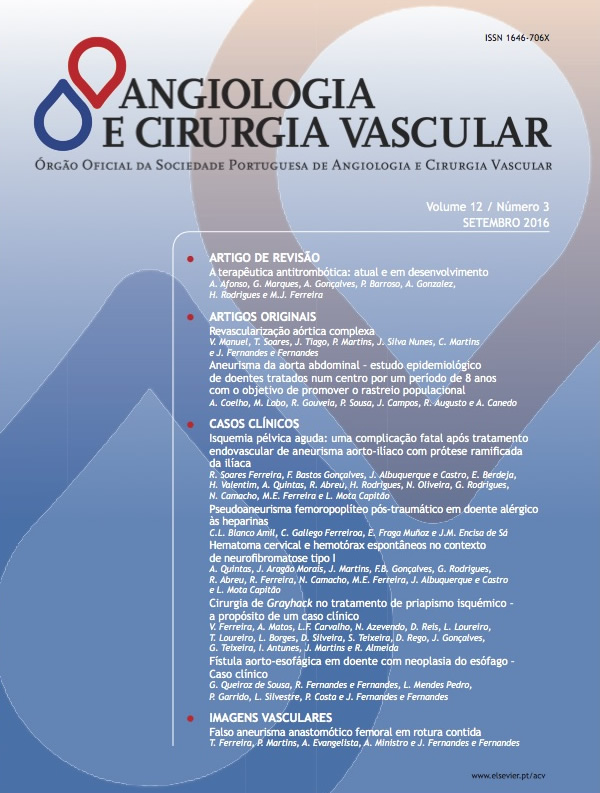Acute pelvic ischemia - a fatal outcome after endovascular aortoiliac aneurysm repair with iliac branch device
DOI:
https://doi.org/10.48750/acv.6Keywords:
Abdominal aortic aneurysm, Endovascular aneurysm repair, Iliac branch device, Acute pelvic ischemiaAbstract
Introduction: The occlusion of internal iliac artery may be necessary in Endovascular Aortic Aneurysm Repair (EVAR). The intentional hypogastric occlusion may have several ischemic complications. The Iliac Branch Devices (IBD) are an alternative to hypogastric occlusion in patients at high risk to pelvic ischemia. The authors report a case of early IBD occlusion with serious clinical consequences. Case Report: A 74-year-old man presented a 55-mm abdominal aortic aneurysm with bilateral involvement of iliac bifurcation and proximal hypogastric arteries (maximum diameter of 31 and 32 mm). He underwent EVAR, left hypogastric revascularization by IBD and coiling + overstenting of contralateral hypogastric. There wasn´t intraoperative complications and final angiography showed hypogastric patency and poor pelvic collateral circulation. Postoperatively, the patient complained of bilateral lumbar and gluteal pain and presented with ischemic skin alterations and left lower limb monoparesis. As his clinical state deteriorates in the first 24 hours and computed tomography angiogram revealed left hypogastric stent occlusion, he underwent hypogastric revascularization again with good angiographic results. Despite successful revascularization, there was a progressive clinical deterioration with irreversible pelvic ischemia and rhabdomyolysis. Death on 5th postoperative day. Conclusion: The acute pelvic ischemia is a serious complication and often a fatal outcome, which may result of bilateral hypogastric artery occlusion. As IBD revascularization failure may be fatal, the authors advise an extra caution in final angiography and a high level of suspicion for postoperative complications. Bilateral hypogastric preservation using IBD may be recommended, if there is a higher risk of technical failure, embolization or poor pelvic collateral circulation.
Downloads
References
2. Rana MA, Kalra M, Oderich GS, et al. Outcomes of open and endovascular repair for ruptured and nonruptured internal iliac artery aneurysms. J Vasc Surg. 2014;59(3):634-44.
3. Elixène Jean-Baptiste, M., PhD,a,b Sophie Brizzi, MD,a,b Michel A. Bartoli, MD, PhD,c et al., Pelvic ischemia and quality of life scores after interventional occlusion of the hypogastric artery in patients undergoing endovascular aortic aneurysm repair. Journal of Vascular Surgery, 2014.
4. Pratesi G, Fargion A, Pulli R, et al. Endovascular treatment of aorto-iliac aneurysms: Four-year results of iliac branch endograft. Eur J Vasc Endovasc Surg. 2013;45(6):607---9.
5. Lin PH, Chen AY, Vij A. Hypogastric artery preservation during endovascular aortic aneurysm repair: Is it important? Semin Vasc Surg. 2009;22:193-200.
6. Parlini G, Verzini F, de Rango P, et al. Long-term results of iliac aneurysm repair with iliac branched endograft: A 5-year experience on 100 consecutive cases. Eur J Vasc Endovasc Surg. 2012;43:287-92.
7. Donas KP, Torsello G, Pitoulias GA, et al. Surgical versus endovascular repair by iliac branch device of aneurysms involving the iliac bifurcation. J Vasc Surg. 2011;53(5):1223-9.
8. Ferreira M, Monteiro M, Lanziotti L. Technical aspects and midterm patency of iliac branched devices. J Vasc Surg. 2010;51:541-50.









